
Eduard 1/48 IAI Dagger (conversion)
| KIT #: | 8494 |
| PRICE: | $CAN $30.00 SRP |
| DECALS: | One option |
| REVIEWER: | Pablo Calceterra |
| NOTES: | Decals from Aerocalcal, nose from Mirage Resin Models |

| HISTORY |
Being
pretty close to go to war against
C-421
was one of the planes of the first batch purchased and was sn-45 in Israeli
inventory.
A second
batch of planes with the remainder planes was offered and accepted by
Neshers
were now baptized Daggers in
After
A)
Escuadron
I was left in Tandil and was used to train pilots (one single seat and three
trainers in service) and also to receive the 10 Mirage 5P that
B)
Escuadron
II was called La Marinete and was based in BAM San Julian
C)
Escuadron
C-421
was part of the last Escuadron Aeromovil and it arrived in
On April
28th 1st
Lt Ratti took C-421 to San Julian, where it would fly as part of La Marinete. On
that same day, yellow ID bands were applied to the planes on the wings and tail.
With the
British Task force getting really close to the area and an alarm of an
approaching air strike to San Julian, all planes were scrambled at
As a
consequence, the Fuerza Aerea
OF1101
(call sign “FIERRO”) was the first one issued to the planes in San Julian. C-421
(Capt. Raul Diaz) and C-412 (Lt. Aguirre Faget) were tasked to fly a
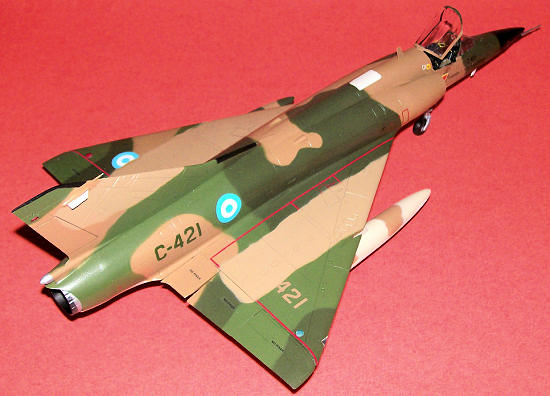
OF 1107 (FORTIN): This one was another
There were
other air to surface actions on May 9th
and 12th but no Dagger was able to
engage their targets.
On May 21st
Operation Sutton started: the British Task force finally landed in San Carlos.
This was the moment that the Argentine Air Force was looking for, as since May 1st
and with the exception of May 12th
the Task Force had kept well to the East of the islands and out of range of the
land based aviation.
Two
sections of 3 planes were scheduled to take off and attack the British ships in
the landing area. These were the LAUCHA and RATON. The OF determined that the
RATONES were supposed to take off first followed by the LAUCHA. But RATON #2 had
problems starting his plane and therefore the order in which they took off was
reversed (for more details about the air combat between the RATONes and Sharky
Ward’s
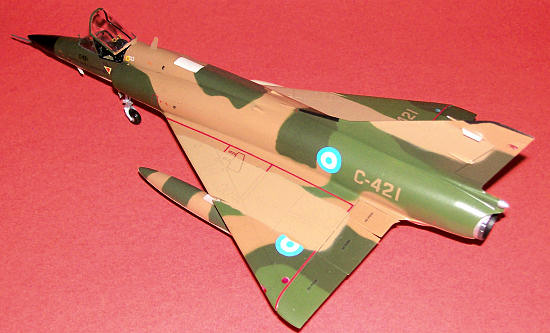 OF1199
(LAUCHA): C-421 with Lt Cesar Roman, C-415 with 1st
Lt Callejo and C-412 with Mj Puga. The typical profile of the planes was
high-low-high (High approach, low close to the islands, attack and initial part
of the return and high return). After descending to the surface during their
approach, Roman misread his clock and commanded his wingmen ”Aceleramos ya!”
(Accelerate now!) but he found his mistake and immediately changed his order.
Once over the last hills before the Sound he now correctly told them to
accelerate and told them that the Sound would be in front of them in a few
seconds. He describes it as if someone had opened the curtains at a theater:
there was a cliff, the blue water full of foam, bays ahead and the frigates like
flowers on a field. Around that time Puga could hear the warning shouts of Maj.
Piuma Justo (RATON 2) to Jorge Senn (RATON 3) for him to evade a Sidewinder. The
RATONes, flying just some miles behind the LAUCHAs, had been intercepted by
Sharky Ward and Steve Thomas. Piuma, flying higher than RATON 3 (with Donadille
already shot down) could see Thomas firing a missile to Senn. Therefore he
started to shout: “Cierre, cierre, cierre, carajo! Cierre, cierre, cierre,
carajo! (Break, break, break, damn it! Break, break, break, damn it!)” But the
missile was faster and Senn’s plane was hit and he ejected. Then silence…Puga
tried to contact his friend Piuma but he had also been shot down. Returning to
the description of this mission, there was one frigate close to the other shore,
towards their left and another one to their right, close to the shore they had
just left behind. Roman picked the one that was in their line of flight. Callejo
picked one that was further to their left. The British ships fired their main
guns and machine guns. These formed geysers of water that the planes had to fly
thru. The Sea Wolf system was unable to lock on the attackers. HMS Broadsword
fired a missile to the Daggers but it missed. The Daggers fired their guns. When
his target filled his windshield, Roman pressed the button but his bombs did not
drop. Puga’s missed the ship. As Callejo was out of sight Roman started his
timer shortly after jumping over the target and called: “Van 20” (that is to say
20 seconds had elapsed since the attack). Damage to HMS Brillant included Sea
Lynx XZ732, the Sea Wolf and Exocet launchers and the sonar equipment. The 30mm
guns and the splinters injured several crewmembers. During the return Puga told
Roman that he had head as if someone had hit his plane with a hammer. A visual
inspection in flight by Roman did not yield any result. Upon landing it was
discovered that both C-412 and 415 had received impacts in their bulletproof
windshields and had to be sent back to Tandil to be fixed. The thousand of
bullets fired did not touch C-421. From this moment onwards Roman’s friends
teased him due to the professionalism and cold blood he displayed during the
mission as he was still calling the reading of the timer when under fire.
OF1199
(LAUCHA): C-421 with Lt Cesar Roman, C-415 with 1st
Lt Callejo and C-412 with Mj Puga. The typical profile of the planes was
high-low-high (High approach, low close to the islands, attack and initial part
of the return and high return). After descending to the surface during their
approach, Roman misread his clock and commanded his wingmen ”Aceleramos ya!”
(Accelerate now!) but he found his mistake and immediately changed his order.
Once over the last hills before the Sound he now correctly told them to
accelerate and told them that the Sound would be in front of them in a few
seconds. He describes it as if someone had opened the curtains at a theater:
there was a cliff, the blue water full of foam, bays ahead and the frigates like
flowers on a field. Around that time Puga could hear the warning shouts of Maj.
Piuma Justo (RATON 2) to Jorge Senn (RATON 3) for him to evade a Sidewinder. The
RATONes, flying just some miles behind the LAUCHAs, had been intercepted by
Sharky Ward and Steve Thomas. Piuma, flying higher than RATON 3 (with Donadille
already shot down) could see Thomas firing a missile to Senn. Therefore he
started to shout: “Cierre, cierre, cierre, carajo! Cierre, cierre, cierre,
carajo! (Break, break, break, damn it! Break, break, break, damn it!)” But the
missile was faster and Senn’s plane was hit and he ejected. Then silence…Puga
tried to contact his friend Piuma but he had also been shot down. Returning to
the description of this mission, there was one frigate close to the other shore,
towards their left and another one to their right, close to the shore they had
just left behind. Roman picked the one that was in their line of flight. Callejo
picked one that was further to their left. The British ships fired their main
guns and machine guns. These formed geysers of water that the planes had to fly
thru. The Sea Wolf system was unable to lock on the attackers. HMS Broadsword
fired a missile to the Daggers but it missed. The Daggers fired their guns. When
his target filled his windshield, Roman pressed the button but his bombs did not
drop. Puga’s missed the ship. As Callejo was out of sight Roman started his
timer shortly after jumping over the target and called: “Van 20” (that is to say
20 seconds had elapsed since the attack). Damage to HMS Brillant included Sea
Lynx XZ732, the Sea Wolf and Exocet launchers and the sonar equipment. The 30mm
guns and the splinters injured several crewmembers. During the return Puga told
Roman that he had head as if someone had hit his plane with a hammer. A visual
inspection in flight by Roman did not yield any result. Upon landing it was
discovered that both C-412 and 415 had received impacts in their bulletproof
windshields and had to be sent back to Tandil to be fixed. The thousand of
bullets fired did not touch C-421. From this moment onwards Roman’s friends
teased him due to the professionalism and cold blood he displayed during the
mission as he was still calling the reading of the timer when under fire.
Follow up
of the attacks of the 21st happened
on the 23rd and OF 1216
(call sign CORAL) meant a new mission for C-421. Target
was the landing area in San Carlos and the section was the following: C-421 with
Capt. Norberto Dimeglio, C-434 1st
Lt. Roman and C-420 with Lt. Aguirre Faget. These Daggers had 2 x 250 kg
parachute-retarded bombs in stations 3 and 5. Roman later on commented than when
they had reached San Carlos waters, they run into another Dagger section (this
time from Rio Grande) that had bombed HMS Broadsword and almost crashed head on
into them! Then the radar controller alerted them that there was a British
Just 5
minutes after midnight on the 24th
the ground crews received the order to over paint the yellow ID bands with green
paint. Driving back from the hotel where they were based, 1st
Lt Posadas and his team rang the bell of every single paint shops in town in
order to find green paint and some brushes. The only thing they were able to get
was some blue greenish paint. At 1 am in the morning they started their work but
the surfaces of the planes had frost and they could not get the paint to stick,
so they were forced to remove the ice and water with cloths and newspapers until
they were able to achieve their objective. The yellow and blue greenish
combination gave the ID bands that kind of “turquoise” color that can be seen in
many pictures.
On this
day (24th) more missions were
scheduled to attack the landing area. OF 1227 (PLATA) was made up of Capt
Dellepiane in C-434, 1st Lt. Musso
(a former Dagger pilot who had volunteered in early April to return to the Air
Force as he was by then a captain in Aerolineas Argentinas) in C-420 and 1st
Lt. Callejo in C-421. Another section (ORO) was supposed to take off first but a
mechanical failure meant that they ceded their place to the PLATA. Like it
happened on the 21st, the second
section (the one that was supposed to take off first) was intercepted and
entirely shot down (look for my C-430 in 1/48 elsewhere for details). PLATA
section reached the target area first flying north of Pebble Island (Borbon) and
then reached the landing area. Musso said that he had to attack the small
harbour in San Carlos and they were fired at with guns, missiles and everything
that the British had at hand. He dropped his bombs on a ground target and he
could see, flying so low, the British soldiers aiming at them with portable anti
aircraft missiles. He made several maneuvers to avoid the enemy fire and finally
arrived to the sea. He thought: “OK, I am saved” but he realized he was flying
to the EAST (towards Africa, as he remembers). Always skimming the waves, he
turned to the continent and close to the Northern entrance of San Carlos waters
he found 2 British ships: HMS Coventry and Broadsword. He started to think:
“they will hit me, they will hit me” but he was not fired at. Some instants
later and using the same escape route Callejo faced the British ships as well.
He flew towards the islands to escape the “42-21 combo” and one of the ships
fired a missile at him though the captain of HMS Coventry says that the planes
were out of range and in his book does not mention firing a missile. Callejo
immediately dropped his 3 empty 1,300 lt. tanks, turned sharply to the right and
succeeded in evading the missile. The seconds it took him to get to the coast of
the islands seemed ages. When the PLATAs landed they found that C-420 had some
impacts of light guns in the right drop tank, C-421 did not release one of the
bombs and C-434 windshield was cracked by an impact of enemy fire. As C-421
touched down and was running towards the tarmac non-commissioned officer Quiroga
(armament expert) realized that arming vane of the still hanging bomb was
turning free. Immediately Callejo was told to stop the plane on the runway, he
deplaned and then the plane was carefully pushed to a “safe area”. Everybody
took cover except for Quiroga, Corporal Diaz and 1st
Lt Posadas who planned how to disarm the bomb. Posadas thought that it all
looked like in the movies…but it was for real! Quiroga was disassembling the
bomb, passing the parts to Diaz who would pass them to Posadas who left them on
the floor. Once the bomb was opened and he could see the mechanism Quiroga
unscrewed the system and after several minutes of hard work and tension he was
able to make the bomb safe. With a scream of joy they left the plane and
celebrated: not only they have saved their lives but also a very needed and
precious plane. It was only then that they realized that the plane was close to
one of the bombs depots and that some of the ground crew had taken cover behind
it!
On May 29th
the Air Force decided to give close support to their beleaguered troops in Goose
Green/Darwin. The by now well-known trio Dimeglio/Roman/Aguirre Faget
constituted the PATRIA section (OF1264). The leader was again Dimeglio in C-420,
with Roman in C-421 and Aguirre Faget in C-416. C-416 had a failure in the
oxygen system so could not take part. The other two planes took off but once in
the air they were told that a section from Rio Grande would attack instead.
Before turning back Dimeglio asked for the authentication code in case the order
to return was actually a British deception. Once he confirmed that the return
order was true, they emptied the external drop tanks, returned and landed. That
very same day, OF 1269 (
On June 4th
another ground attack mission was ordered in which C-421 took part. OF 1277
(PINA) called for 4 Daggers led by Squadron Leader Vice commodore Villar in
C-432 to dive bomb ground troops in Mount Kent. Wingmen were Capt. Demierre
(C-420), 1st Lt Roman (C-416) and 1st
Lt Musso (C-421). They had 4 x 250 parachute retarded bombs. They were guided to
the target 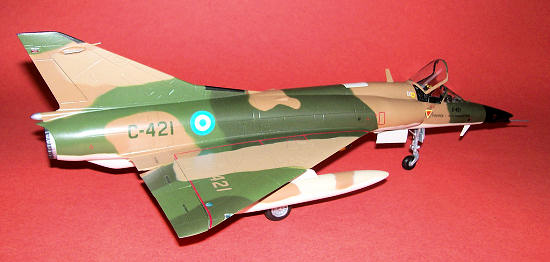 area
at 43,000 ft by the radar in Puerto Argentino (Stanley). Once they arrived they
were told to dive into the overcast below. They were in line and 1,000 mt one
behind the other in order to get their bombs as concentrated as possible and
also to fool any missile that could be fired against them by the troops below.
When they reached 20,000 ft in their 30º dives they dropped their bombs still
inside the clouds and then climbed back to safety.
area
at 43,000 ft by the radar in Puerto Argentino (Stanley). Once they arrived they
were told to dive into the overcast below. They were in line and 1,000 mt one
behind the other in order to get their bombs as concentrated as possible and
also to fool any missile that could be fired against them by the troops below.
When they reached 20,000 ft in their 30º dives they dropped their bombs still
inside the clouds and then climbed back to safety.
On June 5th
NENE section (Capt. Maffeis in C-421, Capt Demierre in C-416 and 1st
Lt Musso in C-432) was tasked to bomb ground positions again. Bae HS-125/700
(LV-ALW) from Fenix Squadron led them. Bad weather prevented them from attacking
even though they reached the target area. The bombs were dropped into the ocean
below on the return leg to avoid an incident like the one on the 24th.
June 8th
is remembered as the Disaster at Bluff Cove. Very effective attacks by the
Argentine Skyhawks provoked great losses to the British Task Force. Contribution
of the Daggers from San Julian was 2 sections (CARTA and SOBRE) that acted as
decoys for the defending Sea Harriers. The crews for SOBRE (OF 1294) were 1st
Lt Musso in C-420, Lt Aguirre Faget in C-421 and Capt. Maffeis in C-416. They
were only armed with their 30 mm guns. Sharky Ward and Steve Thomas were about
to look for Hector Sanchez who was the only survivor of the MAZO section (for
more details see
http://modelingmadness.com/reviews/mod/us/calc204.htm)
when they were called to head for some high flying intruders arriving to the
area. It was the Daggers, which Ward thought could be Mirage IIIEA. He saw the 3
condensation trails getting approaching while he was climbing furiously in order
to intercept them. Ward told Thomas to get ready to break and get on the tail of
the enemies (like happened to Garcia Cuerva and Perona on May 1st)
but when he gained visual the Daggers broke hard and returned to the continent.
They had achieved their objective by luring a
As the
approach routes of the Daggers from San Julian was well known to the British, II
Escuadron was relocated to Rio Gallegos. It would allow them to take a more
southerly route. It is around this date that the “turquoise” ID bands were over
painted with airbrushes using light ran color (very similar to the one of the
cammo).
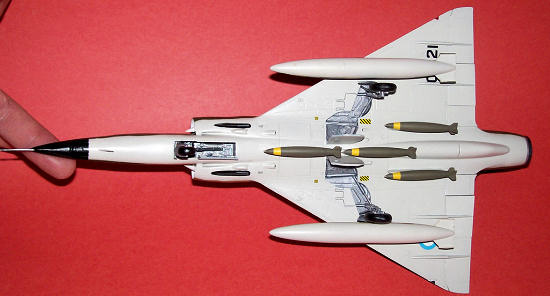 Last
missions of “La Marinete” took place on June 13th.
The GAUCHOs (OF1318) were to attack enemy positions in Mount Longdon. They were
Capt Dimeglio in C-432, 1st Lt
Roman in C-421 and Lt Aguirre Faget in C-412. The last one was not able to take
off due to problems with the brakes. Weather forced GAUCHOs to deviate further
South from their original route and it is there, well offshore that they came
across a solitary Lynx
Last
missions of “La Marinete” took place on June 13th.
The GAUCHOs (OF1318) were to attack enemy positions in Mount Longdon. They were
Capt Dimeglio in C-432, 1st Lt
Roman in C-421 and Lt Aguirre Faget in C-412. The last one was not able to take
off due to problems with the brakes. Weather forced GAUCHOs to deviate further
South from their original route and it is there, well offshore that they came
across a solitary Lynx
On June 14th
the conflict ended with a cease-fire.
C-421
took part in 11 combat missions and along C-418 they were the Daggers that flew
the most during the conflict.
All the
pilots that flew C-421 survived the war, with only Diaz being shot down in C-430
on May 24th and parachuting
(injured) to safety.
On June 25th
the II Escuadron Aeromovil returned to Tandil. They had dropped 84 bombs and
fired 2,920 x 30 mm rounds.
In 1988
C-421 was modified to the Finger IIIB configuration (similar to the Kfir
standard). In 1993 fire in the engine left the plane grounded indefinitely. In
1997 the wings were used to replace the ones of C-426 that had developed fuel
tank leaks. The front of the plane was also used during that year to develop a
prototype for an in flight-refueling probe that was finally never adopted by the
Air Force. In 1998 it was
| THE KIT |
This is the Mirage IIICJ. A great jump in terms of
quality of the kit compared to the old Esci/Italieri offer as it has engraved
panel lines, more details in the wheel wells and there are many more panels
marked (access doors, fuel tanks). It makes an excellent Mirage IIIC. Eduard’s
offer has a somehow shallow fuselage above the wings and the top of the tail is
shorter than Esci/Italieri. I don’t know at this point who got it right, but
when placing both finished planes side by side it is not too hard to see the
difference.
| CONSTRUCTION |
This one was the mother of all my
kit-building nightmares. I converted a Heller MIIIC into an IAI Finger many
years ago and it was not as challenging as this project. Engineering of the kit
is different so the task was not as easy as I had thought it would be when
remembering my Finger conversion.
A friend of mine offered me a
fuselage and nose conversion for this kit. The idea being that I could use
everything except for the fuselage halves from Eduard. Upon receiving the parts
I found that they were badly warped and the only thing I could use by then was
nose itself. By that moment I had already detached the tail from the Eduard
fuselage half as I thought I was going to be able to fix the distorted parts…
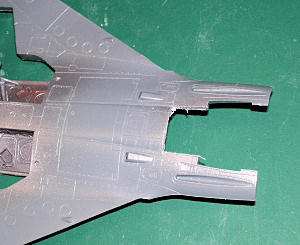 I put
together the cockpit following the directions. I left aside the ejector seat
supplied by the kit as I have my own resin made Mirage seat. Instead of using
the decal I painted the instrument panel.
I put
together the cockpit following the directions. I left aside the ejector seat
supplied by the kit as I have my own resin made Mirage seat. Instead of using
the decal I painted the instrument panel.
All the wheel wells parts were
glued and I painted them in silver. A slight dry brush with brown and black
pastels gave them a little bit of dirty appearance. The front part of the lower
half of the wing/fuselage was cut out to accommodate the future extension of the
fuselage.
I painted in white the interior
part of the top of the wing formation lights and glued them in place. Top and
bottom halves of wings were then glued along with all the internal wing landing
gear structure.
Then I put together the Eduard
fuselage halves,
 minus tail
(previously removed) and nose section (cut behind the air intakes). I found that
the fuselage halves were narrower than the space between the top wing halves.
Therefore I had to push them out. I managed to do it by adding 3 pieces of
plastic spruce inside the fuselage. This left me with a little gap behind the
air intake but after some dry fitting and evaluation I discovered that it would
be impossible to see that gap once the plane was assembled so I left it that
way.
minus tail
(previously removed) and nose section (cut behind the air intakes). I found that
the fuselage halves were narrower than the space between the top wing halves.
Therefore I had to push them out. I managed to do it by adding 3 pieces of
plastic spruce inside the fuselage. This left me with a little gap behind the
air intake but after some dry fitting and evaluation I discovered that it would
be impossible to see that gap once the plane was assembled so I left it that
way.
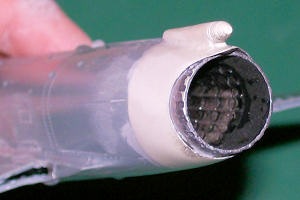 The
final result of the wing/fuselage joint was very satisfactory. Now I was able to
attach exhaust area to the fuselage. My friend’s piece was very good and the fit
was excellent. The internal exhaust is from his set but the “lip” or petals are
a resin copy of the Esci kit as his would not fit inside the fuselage.
The
final result of the wing/fuselage joint was very satisfactory. Now I was able to
attach exhaust area to the fuselage. My friend’s piece was very good and the fit
was excellent. The internal exhaust is from his set but the “lip” or petals are
a resin copy of the Esci kit as his would not fit inside the fuselage.
Now I could add the tail again,
using a considerable amount of putty and sandpaper to fix my (unnecessary) mess.
Then it was the turn of the fuel tank located under the fuselage close to the tail. Of course, this is not present in
the MIIIC. Many years ago I also made a rubber cast from the Esci kit. I made
several copies foreseeing several conversions and I took one for those resin
parts and glued it to the Eduard kit. It fits very well but I used a
considerable amount of putty to fill the gap between tank and fuselage.
located under the fuselage close to the tail. Of course, this is not present in
the MIIIC. Many years ago I also made a rubber cast from the Esci kit. I made
several copies foreseeing several conversions and I took one for those resin
parts and glued it to the Eduard kit. It fits very well but I used a
considerable amount of putty to fill the gap between tank and fuselage.
Now to the most difficult area:
the cockpit area. Not only the Daggers has a different nose, but like the MIIIE
there has been an extra fuel tank installed after the cockpit so this area is
longer than in the MIIIC. So fitting the cockpit to the fuselage was not going
to be enough. I had to find a way to move the cockpit forward. This would leave
me with lots of gaps in the fuselage and air intakes area.
After much pondering I decided to extend it using
plasticard. The problem was the curved top of the fuselage. I found that one of
the resin pouring casts I made in the past had almost the same contour as the
top of the fuselage and could be a good fit. With
 some sanding
to reduce it’s size I installed it using two-part epoxy glue. The initial look
was messy, but quite accurate. Some putty and sanding gave me a smooth surface
with no gaps or bumps.
some sanding
to reduce it’s size I installed it using two-part epoxy glue. The initial look
was messy, but quite accurate. Some putty and sanding gave me a smooth surface
with no gaps or bumps.
Then it was time to fit the cockpit area to the rest
of the plane. I found that there was now a gap at the bottom so an extra piece
of plasticard covered it. I used considerable amounts of two-part epoxy glue in
this area. The nose would not sit as I wanted and after lots of twisting and
fighting against the glue and the plastic I was able to stand the plane on its
tai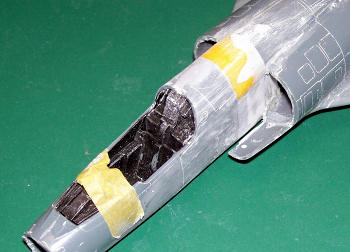 l
and leave it like that overnight. Regretfully all that fight with the sticky
glue and the position the kit had during the night gave me a slightly dropped
attitude for the nose…something that I did not discovered until later on when I
shared some of my pictures of my ready to paint kit with my friends…but by then
it was too late unless I had decided to get a saw or similar to cut the plastic
out and start all that area all over again…
l
and leave it like that overnight. Regretfully all that fight with the sticky
glue and the position the kit had during the night gave me a slightly dropped
attitude for the nose…something that I did not discovered until later on when I
shared some of my pictures of my ready to paint kit with my friends…but by then
it was too late unless I had decided to get a saw or similar to cut the plastic
out and start all that area all over again…
Then it was the time of the air
intakes. First I needed to fix them to the fuselage. Instead of going thru the
painful process of scratchbulding the air canalizers underneath them, I took the
easy road and just copied in plasticard the triangles present in the Esci kit.
The intakes themselves had to be extended as well using
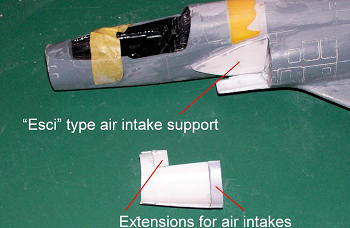 strips from
the Heller kit air intakes that were not used during my Finger conversion
project.
strips from
the Heller kit air intakes that were not used during my Finger conversion
project.
The end result, once I attached the Dagger nose, was quite good…except for the dropped fuselage front area.
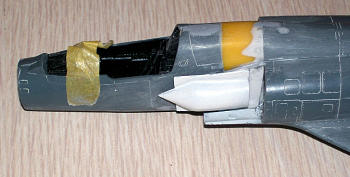 The support
for the ILS antennas on top of the tail was scratchbuilt following some pictures
and glued in place. It was also at this point that I realized that Eduard does
not have to little air vents under the fuselage close to the guns area. I
scratchbuild them using some unused rockets from the Hobbycraft Me 109s.
The support
for the ILS antennas on top of the tail was scratchbuilt following some pictures
and glued in place. It was also at this point that I realized that Eduard does
not have to little air vents under the fuselage close to the guns area. I
scratchbuild them using some unused rockets from the Hobbycraft Me 109s.
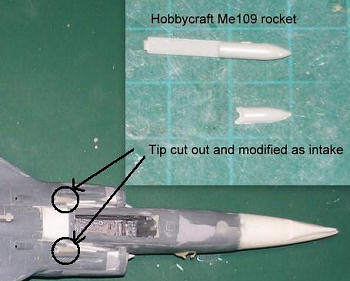 For the
configuration I decided to build (June 4th
with 2 drop tanks and 4 bombs) I found that the drop tanks supplied by Eduard
are too small. Luckily, when I made my Garcia Cuerva’s Mirage IIIEA I was left
with 2 x 1,300 lt unused tanks! The only problem wa
For the
configuration I decided to build (June 4th
with 2 drop tanks and 4 bombs) I found that the drop tanks supplied by Eduard
are too small. Luckily, when I made my Garcia Cuerva’s Mirage IIIEA I was left
with 2 x 1,300 lt unused tanks! The only problem wa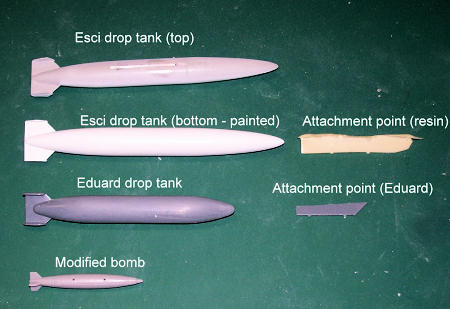 s
that I did not have any more attachment points / stations so I had to copy some
in resin. These along with some bomb racks from Hobbycraft’s Skyhawks were glued
under the plane.
s
that I did not have any more attachment points / stations so I had to copy some
in resin. These along with some bomb racks from Hobbycraft’s Skyhawks were glued
under the plane.
Flaperons where glued in a slightly
dropped position and that required some careful cutting of the fairing for the
actuator under the wings.
Bombs were from the Hobbycraft A4 kits and I modified
the nose to represent the proper fuse used during this mission.
With this, I was ready to start
painting.
| COLORS & MARKINGS |
I gave the plane a coat of light
gray to check for imperfections and also to give a better surface for the MM
Acryl paints to adhere.
I then masked the area for the ID b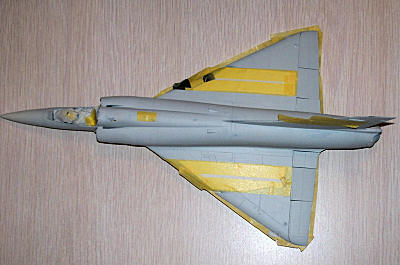 ands
knowing that it would be easier to cover it if there was no camo underneath.
Anyways, there would have been a solid colour in the original planes
(turquoise).
ands
knowing that it would be easier to cover it if there was no camo underneath.
Anyways, there would have been a solid colour in the original planes
(turquoise).
I used Model Master Acrylic paints.
First I used Light gray (4766) for all the undersurfaces, followed by Tan
(4709), then Medium Green (4734) and finally Dark Green (4726). The lines
between colours are smooth so I used Blue Tac to obtain the desired effect.
The ID bands were painted using Tan
(4709) and some drops of white. As there are several stencils that would have
been over sprayed in this colour I masked those decals with Blue Tac and also
gave them a hand of this light tan.
As there were many Peruvian 1,300
drop tanks in use by then I painted one of C-421’s in radome tan and tan (4709)
with dirty white undersides.
Tip of the bombs was painted in
yellow and then in Olive drab. For the nose and several details like edge of
tail I used flat black.
I painted the scratchbuilt VHF
antennas were in tan (top) and dirty white (bottom).
The entire top
surface was given some coats of Future until I was satisfied with the gloss.
Just after I finished and while I was admiring the gloss finish I looked at a
1979 p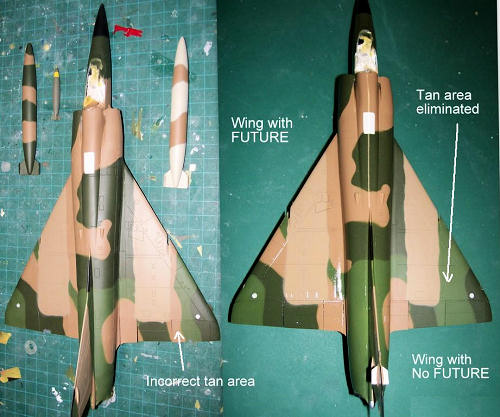 icture
of C-421 in flight and it dawned on me that some days ago I had realized that
the right wing had NO tan cammo except for the area close to the fuselage!!!
Cursing in Spanish and English. I was left with 3 options: leave as it was (no
way!), try to over spray green after masking the area (which experience has
shown me that does not work as the Acryl paints crack when applied over Future)
or remove the freshly applied layers of Future. I went for the last option using
cotton with Windex and water. I tried to limit the removal to the tan area but
it started to snowball to a point where I had to leave all the right wing with
no Future. A couple of days later I masked the wing, gave it the proper green
color and the day after I applied Future again.
icture
of C-421 in flight and it dawned on me that some days ago I had realized that
the right wing had NO tan cammo except for the area close to the fuselage!!!
Cursing in Spanish and English. I was left with 3 options: leave as it was (no
way!), try to over spray green after masking the area (which experience has
shown me that does not work as the Acryl paints crack when applied over Future)
or remove the freshly applied layers of Future. I went for the last option using
cotton with Windex and water. I tried to limit the removal to the tan area but
it started to snowball to a point where I had to leave all the right wing with
no Future. A couple of days later I masked the wing, gave it the proper green
color and the day after I applied Future again.
The Aerocalcas set is very good overall but the only
criticism I have is that the red triangles (Danger / Ejection / Seat) are
oversized. I decided to make my own using clear and white decal paper and my ink
jet printer. I scanned the Aerocalcas drawings, modified them using some basic
PC programs and printed several copies.
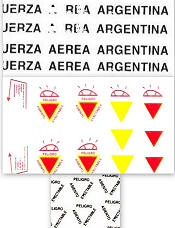 The words
“FUERZA AEREA ARGENTINA” are clearly worn out in some areas on the right side of
C-421. So here I scanned them too, and using a basic photo editor program
“airbrushed” out those missing letters.
The words
“FUERZA AEREA ARGENTINA” are clearly worn out in some areas on the right side of
C-421. So here I scanned them too, and using a basic photo editor program
“airbrushed” out those missing letters.
For stencils I used the Aerocalcas supplied ones and
supplemented them with some of Eduard, some from Esci when needed.
The green “2” for the back of the right side of the
fuselage is not present in the Aerocalcas set. I made it up with a “0” and other
green numbers supplied in the Aerocalcas sheet. Note the lightly airbrushed red
no walk zone stencils.
With all decals in place I was
ready for the final steps.
| FINAL CONSTRUCTION |
I glued the landing gear. The
entire plane was given a coat of satin varnish.
Details included:
1.
Two ILS antennas on the tail using Evergreen
2.
VHF antennas on fuselage
3.
Using a piece from the spares box I made the housing for an non-existing
RWS and placed it on the border of attack of the tail at the same height as the
ILS antennas
4.
Landing gear doors
5.
Bombs (x 4) using wing
supports from Hobbycraft (A4-B)
6.
Drop tanks
7.
Painted navigation lights with a mix of Future and a drop or red or
green
8.
Braking parachute cap in aluminum
9.
Scratchbuilt landing lights on the nose landing gear using round clear
ejector pins from the spares box, then painted in Chrome silver – front – and
aluminum – back
10.
Small air intake in front of the windshield made with the original
Eduard one cut to the correct shape and size
11.
Glued the ejection seat
12.
Scratchbuilt and glued to the top of the windshield the clock (left
side) and compass (right side)
13.
Attached the top ejection handles painted in yellow with pen painted
black stripes
14.
Gunsight (Eduard)
15.
Photo etched rear mirrors (painted in black and chrome silver) attached
to the hood
16.
30 mm
guns, previously painted in black with an aluminum mouth to highlight the
excellent Eduard representation Picture Guns
17.
Windshield (terrible fit that required scraping, sanding and painting to
get a decent but not perfect fit)
18.
Hood in opened position
19.
And the final touch was
the Pitot tube painted in aluminum with a chrome silver tip.
| CONCLUSIONS |
An Argentine Dagger full of history. I put all my
efforts to make a well deserving kit. Regretfully, the nose down attitude has
ruined to some degree all the hard work I put during the last 5 months. The
quality of the Eduard kit is excellent, details are more subtle when compared to
Esci/Italieri kits but I would not tackle a conversion like this one EVER again
even if I am given the IIICJ kit for free and I am paid to do it. I will keep on
using the Esci kits, which are easier to work with, and cost a fraction of the
Eduard one (I saw the Eduard Kfir kit during this past weekend at almost CAN 50.
A probably much better starting point…but CAN 20 more expensive!)
Thanks to:
·
Guillermo Donadille, Jorge Senn and Raul Diaz for their time and
patience.
·
Jose Luis Martinez Eyheramendy for his research of pictures of C-421
from all angles possible (he was a ground crew of the La Marinette Squadron
during the war. His memoirs are published in his blog Mis Vivencias de Malvinas)
·
Juan Contreras for his relentless support with information
·
Jose Miguel
Dedicated to:
The TORNOs (and in them all the
other unsung and humble Halcones like Musso), who even in inferior technical
conditions chased away a British
| REFERENCES |
· Halcones de Malvinas (Pablo Carballo)
·
Historia Oficial de la Fuerza Aerea, Volumen 6 (Malvinas), Book 1 and 2
·
Ellos tambien combatieron (Guillermo Posadas) – in charge of Maintenance
of the II Escuadron Aeromovil during the war
·
Guerra Aerea en las Malvinas (Benigno Andrada)
·
Dagger & Finger en Argentina (Horacio Claria et al.)
·
Four weeks in May – Capt. Hart-Dyke
·
Falklands Air War - Hobson
·
IAI Finger 1978-1982 - Nunez Padin
· Sea Harrier over the Falklands – Sharky Ward
March 2011
If you would like your product reviewed fairly and quickly, please contact me or see other details in the Note to Contributors.